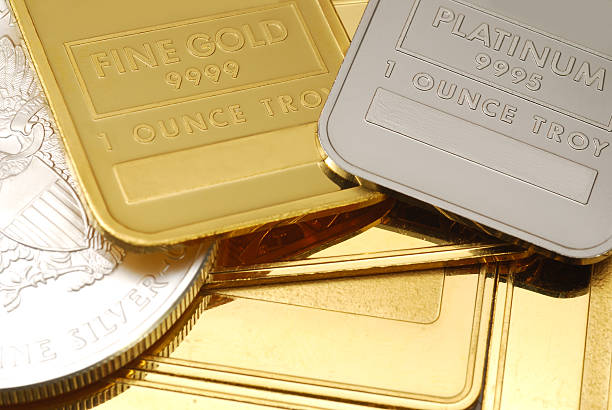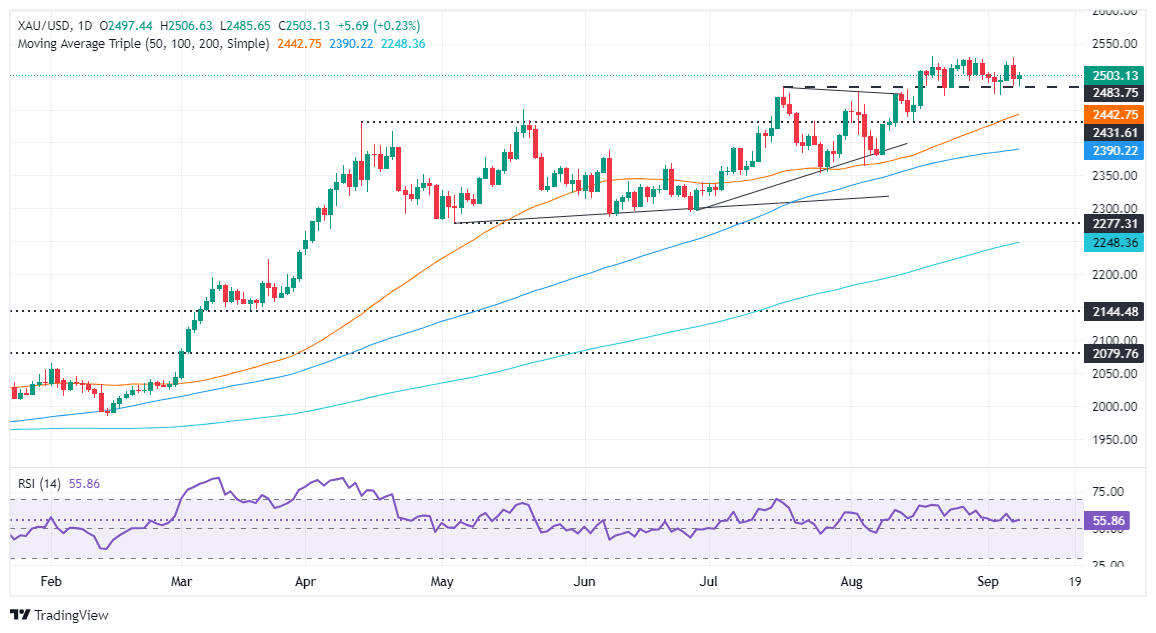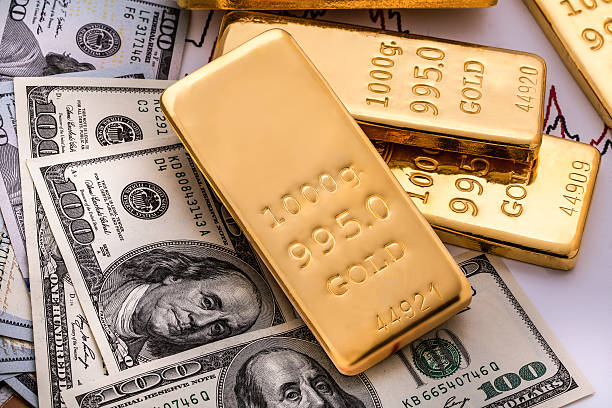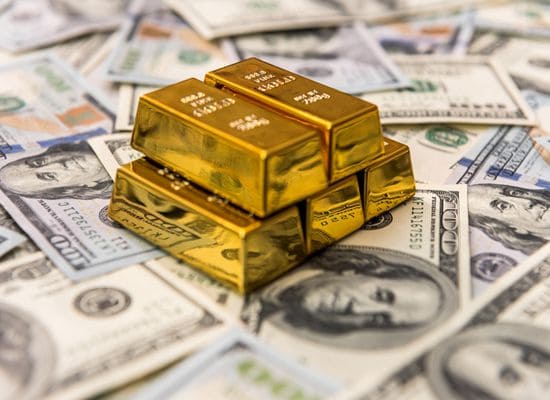Gold price holds to gains above $2,500 amid steady US yields

- Gold gains ground despite broad US Dollar strength, traders focus on the upcoming US Consumer Price Index (CPI) release.
- CME FedWatch Tool shows 73% odds of a 25 bps Fed rate cut, shifting from previous speculation of a 50 bps move.
- US Treasury yields remain stable, while traders await further clues on inflation trends and the Fed’s rate path.
Gold gained ground on Monday as traders braced for the release of August’s inflation report in the United States (US) and looked for hints that the Federal Reserve (Fed) would cut rates by 50 or 25 basis points. At the time of writing, XAU/USD trades at $2,502, up by 0.23%.
Market mood improved during the overnight session for North American traders, as evidenced by solid gains in US equities. US Treasury bond yields retreated somewhat along the short and long end of the curve with the 10-year T-note yielding 3.706% unchanged compared to last Friday’s close.
Bullion traders ignored broad US Dollar strength as the Greenback posted gains of over 0.30%, according to the US Dollar Index (DXY), which measures the buck’s performance against six currencies.
Meanwhile, traders pared odds for a 50 bps rate cut following last Friday’s Nonfarm Payrolls (NFP) figures, which despite missing the mark showed the Unemployment Rate ticking lower from 4.3% to 4.2%. Now, eyes are on the release of the Consumer Price Index (CPI), which is expected to dip further toward the Fed’s 2% goal.
The CME FedWatch Tool shows that the odds for a 25 bps Fed rate cut increased to 73%, while the odds for 50 bps lie at 27%.
Sources quoted by Reuters noted, “The market seems to be reconciling that the Fed is probably more likely to do the smaller 25-basis-point cut, and that's been my position all along.”
Earlier, the US economic docket featured the New York Fed inflation expectations report, which showed that prices remain anchored to the 3% threshold, unchanged from the previous survey though slightly above the Fed’s target.
Daily digest market moves: Gold price climbs as traders eye US CPI
- US CPI is expected to decline from 2.9% to 2.6% YoY in August, while core CPI is projected to remain at 3.2%.
- Last week’s NFP report revealed the economy added over 142K employees to the workforce but missed consensus of 160K. However the dip in the Unemployment Rate lent a lifeline to the Greenback.
- Last Friday, Fed officials were dovish. New York Fed President John Williams said that cutting rates will help keep the labor market balanced, while Governor Christopher Waller said that “the time has come” to ease policy.
- Chicago Fed President Austan Goolsbee was dovish, saying policymakers have an “overwhelming” consensus to reduce borrowing costs.
- It is worth noting that Fed officials entered their blackout period ahead of the Federal Open Market Committee (FOMC) monetary policy meeting.
- Data from the Chicago Board of Trade (CBOT) indicates that the Fed is anticipated to cut at least 104.5 basis points (bps) this year, based on the fed funds rate futures contract for December 2024.
- China's central bank pauses Gold purchases for a fourth month in August.
Technical outlook: Gold price buyers reclaim $2,500
Gold prices resumed their uptrend above $2,500, though buyers seem to be failing to gather steam with prices below $2,510.
Momentum remains bullish, but the yellow metal could consolidate in the short term before resuming its uptrend or turning lower. The Relative Strength Index (RSI) is almost flat, suggesting that neither buyers nor sellers are in charge.
If XAU/USD climbs above the year-to-date high at $2,531, that could sponsor a leg-up to challenge $2,550. If surpassed, the next stop would be the psychological $2,600 mark.
On the other hand, if Gold prices drop below $2,500, the next support would be the August 22 low at $2,470. If broken, the next demand zone would be the confluence of the May 20 high, which turned into support, and the 50-day Simple Moving Average (SMA) between $2,450 and $2,440.

Inflation FAQs
What is inflation?
Inflation measures the rise in the price of a representative basket of goods and services. Headline inflation is usually expressed as a percentage change on a month-on-month (MoM) and year-on-year (YoY) basis. Core inflation excludes more volatile elements such as food and fuel which can fluctuate because of geopolitical and seasonal factors. Core inflation is the figure economists focus on and is the level targeted by central banks, which are mandated to keep inflation at a manageable level, usually around 2%.
What is the Consumer Price Index (CPI)?
The Consumer Price Index (CPI) measures the change in prices of a basket of goods and services over a period of time. It is usually expressed as a percentage change on a month-on-month (MoM) and year-on-year (YoY) basis. Core CPI is the figure targeted by central banks as it excludes volatile food and fuel inputs. When Core CPI rises above 2% it usually results in higher interest rates and vice versa when it falls below 2%. Since higher interest rates are positive for a currency, higher inflation usually results in a stronger currency. The opposite is true when inflation falls.
What is the impact of inflation on foreign exchange?
Although it may seem counter-intuitive, high inflation in a country pushes up the value of its currency and vice versa for lower inflation. This is because the central bank will normally raise interest rates to combat the higher inflation, which attract more global capital inflows from investors looking for a lucrative place to park their money.
How does inflation influence the price of Gold?
Formerly, Gold was the asset investors turned to in times of high inflation because it preserved its value, and whilst investors will often still buy Gold for its safe-haven properties in times of extreme market turmoil, this is not the case most of the time. This is because when inflation is high, central banks will put up interest rates to combat it. Higher interest rates are negative for Gold because they increase the opportunity-cost of holding Gold vis-a-vis an interest-bearing asset or placing the money in a cash deposit account. On the flipside, lower inflation tends to be positive for Gold as it brings interest rates down, making the bright metal a more viable investment alternative.






